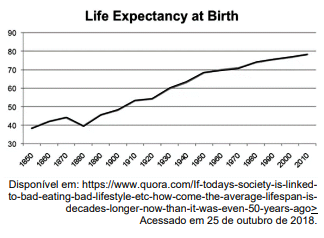Leia o texto para responder à questão.
Poverty may hinder kids’ brain development, study says
Reduced gray matter, lower test scores reported for poor children
July 20, 2015

Poverty appears to affect the brain development of
children, hampering the growth of gray matter and impairing
their academic performance, researchers report. Poor children
tend to have as much as 10 percent less gray matter in several
areas of the brain associated with academic skills, according
to a study published July 20 in JAMA Pediatrics. “We used to
think of poverty as a ‘social’ issue, but what we are learning
now is that it is a biomedical issue that is affecting brain
growth,” said senior study author Seth Pollak, a professor of
psychology, pediatrics, anthropology and neuroscience at the
University of Wisconsin-Madison.
The results could have profound implications for the
United States, where low-income students now represent the
majority of kids in public schools, the study authors said in
background information. Fifty-one percent of public school
students came from low-income families in 2013.
Previous studies have shown that children living in poverty tend to perform poorly in school, the authors say. They have
markedly lower test scores, and do not go as far in school as
their well-off peers.
To see whether this is due to some physical effect that
poverty might have on a child’s brain, Pollak and his colleagues
analyzed MRI scans of 389 typically developing kids aged 4
to 22, assessing the amount of gray matter in the whole brain
as well as the frontal lobe, temporal lobe and hippocampus.
“Gray matter contains most of the brain’s neuronal cells,”
Pollak said. “In other words, other parts of the brain – like
white matter – carry information from one section of the brain
to another. But the gray matter is where seeing and hearing,
memory, emotions, speech, decision making and self-control
occur.”
Children living below 150 percent of the federal poverty
level – US$ 36,375 for a family of four – had 3 percent to 4
percent less gray matter in important regions of their brain,
compared to the norm, the authors found. Those in families
living below the federal poverty level fared even worse, with
8 percent to 10 percent less gray matter in those same brain
regions. The federal poverty level in 2015 is US$ 24,250 for
a family of four. These same kids scored an average of four
to seven points lower on standardized tests, the researchers
said.
The team estimated that as much as 20 percent of
the gap in test scores could be explained by reduced
brain development. A host of poverty-related issues likely
contribute to developmental lags in children’s brains, Pollak
said. Low-income kids are less likely to get the type of
stimulation from their parents and environment that helps
the brain grow, he said. For example, they hear fewer new
words, and have fewer opportunities to read or play games.
Their brain development also can be affected by factors
related to impoverishment, such as high stress levels, poor
sleep, crowding and poor nutrition, Pollak said.
This study serves as a call to action, given what’s already
known about the effects of poverty on child development, said
Dr. Joan Luby, a professor of child psychiatry at Washington
University School of Medicine in St. Louis. “The thing that’s
really important about this study in the context of the broader
literature is that there really is enough scientific evidence to
take public health action at this point,” said Luby, who wrote an
editorial accompanying the study. “Poverty negatively affects
brain development, and we also know that early interventions
are powerfully effective,” Luby said. “They are more effective
than interventions later in life, and they also are cost-effective.”
(www.nlm.nih.gov. Adaptado.)





